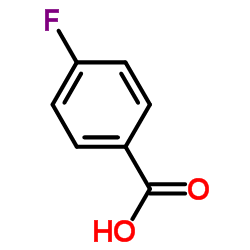4-Fluorobenzoic acid

4-Fluorobenzoic acid structure
|
Common Name | 4-Fluorobenzoic acid | ||
|---|---|---|---|---|
| CAS Number | 456-22-4 | Molecular Weight | 140.112 | |
| Density | 1.3±0.1 g/cm3 | Boiling Point | 253.7±13.0 °C at 760 mmHg | |
| Molecular Formula | C7H5FO2 | Melting Point | 184 °C | |
| MSDS | Chinese USA | Flash Point | 107.2±19.8 °C | |
| Symbol |


GHS05, GHS07 |
Signal Word | Danger | |
|
Characterization of (18)F-dipicolylamine (DPA) derivatives in cells infected with influenza virus.
Nucl. Med. Biol. 42(3) , 283-91, (2015) Bis(Zn-dipicolylamine (Zn-DPA)) coordination complexes represent a new class of synthetic small molecules that can target anionic phosphatidylserine (PS) in the apoptotic cells with high affinity and specificity. In this study, we labeled Zn-DPA and Cy7-Zn-DP... |
|
|
The many roles for fluorine in medicinal chemistry.
J. Med. Chem. 51 , 4359-69, (2008)
|
|
|
NADPH-dependent reductive ortho dehalogenation of 2,4-dichlorobenzoic acid in Corynebacterium sepedonicum KZ-4 and Coryneform bacterium strainNTB-1 via 2,4-dichlorobenzoyl coenzyme A.
J. Bacteriol. 178(9) , 2656-61, (1996) Corynebacterium sepedonicum KZ-4, described earlier as a strain capable of growth on 2,4-dichlorobenzoate (G.M. Zaitsev and Y.N. Karasevich, Mikrobiologiya 54:356-369, 1985), is known to metabolize this substrate via 4-hydroxybenzoate and protocatechuate, and... |
|
|
Isolation and properties of a pure bacterial strain capable of fluorobenzene degradation as sole carbon and energy source.
Environ. Microbiol. 7(2) , 294-8, (2005) A pure bacterial strain capable of aerobic biodegradation of fluorobenzene (FB) as the sole carbon and energy source was isolated by selective enrichment from sediments collected from a polluted site. 16S rRNA and fatty acid analyses support that strain F11 b... |
|
|
Biodegradation kinetics of 4-fluorocinnamic acid by a consortium of Arthrobacter and Ralstonia strains.
Biodegradation 23(1) , 117-25, (2012) Arthrobacter sp. strain G1 is able to grow on 4-fluorocinnamic acid (4-FCA) as sole carbon source. The organism converts 4-FCA into 4-fluorobenzoic acid (4-FBA) and utilizes the two-carbon side-chain for growth with some formation of 4-fluoroacetophenone as a... |
|
|
Biodegradation of polyfluorinated biphenyl in bacteria.
Biodegradation 22(4) , 741-9, (2011) Fluorinated aromatic compounds are significant environmental pollutants, and microorganisms play important roles in their biodegradation. The effect of fluorine substitution on the transformation of fluorobiphenyl in two bacteria was investigated. Pseudomonas... |
|
|
Genuine genetic redundancy in maleylacetate-reductase-encoding genes involved in degradation of haloaromatic compounds by Cupriavidus necator JMP134.
Microbiology 155(Pt 11) , 3641-51, (2009) Maleylacetate reductases (MAR) are required for biodegradation of several substituted aromatic compounds. To date, the functionality of two MAR-encoding genes (tfdF(I) and tfdF(II)) has been reported in Cupriavidus necator JMP134(pJP4), a known degrader of ar... |
|
|
Synthesis, biological activity and HPLC validation of 1,2,3,4-tetrahydroacridine derivatives as acetylcholinesterase inhibitors
Eur. J. Med. Chem. 46(8) , 3250-7, (2011) The synthesis and biochemical evaluation of new hybrids of tacrine (THA) and 4-fluorobenzoic acid (4-FBA) possessing activity towards acetylcholinesterase (AChE) and butyrylcholinesterase (BuChE) inhibition are presented. The compounds of interest were obtain... |
|
|
Brain uptake of the acid metabolites of F-18-labeled WAY 100635 analogs.
J. Cereb. Blood Flow Metab. 23(2) , 249-60, (2003) The 5-HT1A ligands [ 18F]FPWAY and [ 18F]FCWAY are metabolized to [ 18F]fluorobenzoic acid (FB) and [ 18F]fluorocyclohexanecarboxylic acid (FC), respectively. To quantify the penetration of these acids into the brain, dynamic positron emission tomography stud... |
|
|
Fully automated preparation of n.c.a. 4-[18F]fluorobenzoic acid and N-succinimidyl 4-[18F]fluorobenzoate using a Siemens/CTI chemistry process control unit (CPCU).
Appl. Radiat. Isot. 65(2) , 199-203, (2007) The widely used bifunctional labeling reagent 4-[18F]fluorobenzoic acid ([18F]FBA) and its activated form N-succinimidyl 4-[18F]fluorobenzoate ([18F]SFB) were prepared using a modified Siemens/CTI chemistry process control unit (CPCU) double vessel [18F]FDG m... |